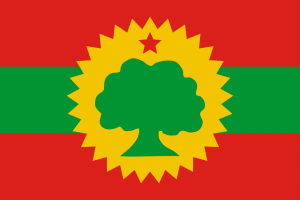Language/Borana-arsi-guji-oromo/Grammar/Basic-Sentence-Structure
Borana-Arsi-Guji Oromo is a Cushitic language spoken by the Borana, Arsi, and Guji Oromo people in Southern Ethiopia and parts of Northern Kenya. In this lesson, you will learn about the basic sentence structure of Borana-Arsi-Guji Oromo. By the end of this lesson, you will be able to construct simple sentences in Borana-Arsi-Guji Oromo using the correct word order for subjects, verbs, and objects.
Word Order in Borana-Arsi-Guji Oromo Sentences
Borana-Arsi-Guji Oromo typically follows a Subject-Object-Verb (SOV) word order. This means that the subject of the sentence comes first, followed by the object, and then the verb. The verb always comes at the end of the sentence. This word order is illustrated in the example below:
| Borana-Arsi-Guji Oromo | Pronunciation | English |
|---|---|---|
| Ganfuree | gan-fu-re | Ganfuree (subject) |
| gaazee | ga-ze-e | bicycle (object) |
| baaddaltti | baad-dal-ti | ride (verb) |
Translation: Ganfuree rides a bicycle.
In the above example, "Ganfuree" is the subject, "gaazee" is the object, and "baaddaltti" is the verb. Note that the verb always comes at the end of the sentence in Borana-Arsi-Guji Oromo.
It is possible to deviate from the SOV word order in Borana-Arsi-Guji Oromo, but doing so changes the emphasis of the sentence. For example, placing the object of the sentence before the subject gives more emphasis to the object. Placing the verb before the subject places more emphasis on the action being described. Examples of these variations are shown below:
| Borana-Arsi-Guji Oromo | Pronunciation | English |
|---|---|---|
| gaazee | ga-ze-e | bicycle (object) |
| Ganfuree | gan-fu-re | Ganfuree (subject) |
| baaddaltti | baad-dal-ti | ride (verb) |
Translation: A bicycle, Ganfuree rides.
In the above example, the object "gaazee" is placed before the subject "Ganfuree," emphasizing the object.
| Borana-Arsi-Guji Oromo | Pronunciation | English |
|---|---|---|
| baaddaltti | baad-dal-ti | ride (verb) |
| Ganfuree | gan-fu-re | Ganfuree (subject) |
| gaazee | ga-ze-e | bicycle (object) |
Translation: Rides Ganfuree a bicycle.
In the above example, the verb "baaddaltti" is placed before the subject "Ganfuree," emphasizing the action being described.
Negation in Borana-Arsi-Guji Oromo
To create negative sentences in Borana-Arsi-Guji Oromo, the word "ama" is added before the verb. The negation marker "ama" is equivalent to "not" in English. Examples are shown below:
| Borana-Arsi-Guji Oromo | Pronunciation | English |
|---|---|---|
| Ganfuree | gan-fu-re | Ganfuree (subject) |
| gaazee | ga-ze-e | bicycle (object) |
| ama baaddaltee | a-ma baad-dal-tee | does not ride (verb) |
Translation: Ganfuree does not ride a bicycle.
In the above example, "ama" is added before the verb "baaddaltee" to create the negation "does not ride."
Question Formation in Borana-Arsi-Guji Oromo
Questions in Borana-Arsi-Guji Oromo are typically formed by adding the question particle "keen" at the end of the sentence. The word order of the sentence does not change, but the intonation rises at the end to indicate a question. Examples are shown below:
| Borana-Arsi-Guji Oromo | Pronunciation | English |
|---|---|---|
| Ganfuree | gan-fu-re | Ganfuree (subject) |
| gaazee | ga-ze-e | bicycle (object) |
| baaddaltti keen | baad-dal-ti keen | Does Ganfuree ride a bicycle? (verb) |
Translation: Does Ganfuree ride a bicycle?
In the above example, "keen" is added to the end of the sentence to indicate a question.
Conclusion
In this lesson, you have learned about the basic sentence structure of Borana-Arsi-Guji Oromo, including the subject-object-verb word order, negation, and question formation. Practicing building sentences using these structures will help you become more proficient in the language as you progress through the Complete 0 to A1 Borana-Arsi-Guji Oromo Course.

